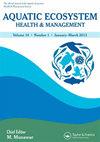伊利湖水体中的硝化作用:季节模式、群落动态以及与蓝藻有害藻华的竞争
IF 0.8
4区 环境科学与生态学
Q4 ENVIRONMENTAL SCIENCES
引用次数: 0
摘要
本研究报告直接测量了伊利湖西部水体的硝化率,伊利湖西部每年都会受到蓝藻有害藻类大量繁殖的影响,伊利湖的三个流域都是如此。在三个野外季节中,采用 15NH4 + 稳定同位素示踪剂来量化硝化率,并通过 qPCR 测定氨氧化细菌和氨氧化古细菌的相对丰度。硝化率从检测不到到 1,270 nmol L-1 d-1 不等,一般来说,西部盆地靠近毛米河口(主要营养源)的硝化率最高。硝化率在初夏最高,通常在蓝藻有害藻华高峰期(8 月和 9 月)最低,然后在 10 月再次上升。在西部流域,硝化率与蓝藻生物量呈负相关。伊利湖三个流域之间的硝化率没有一致的差异。在伊利湖西部的三年中,氨氧化细菌和氨氧化古细菌的丰度通常较高且相似,但总体而言,氨氧化细菌的丰度超过了氨氧化古细菌,尤其是在 2017 年。没有观察到硝化率与氨氧化细菌和氨氧化古细菌丰度之间的关系。因此,尽管氨氧化酶 DNA 丰度很高,但蓝藻有害藻华期间较低的硝化率表明,在蓝藻有害藻华期间硝化细菌是再生和可用 NH4 + 的不良竞争者,这在类似系统中也有观察到。蓝藻有害藻华期间的低硝化率可能会限制系统通过反硝化作用脱氮,而反硝化作用是脱氮的自然途径,也是一种宝贵的生态系统服务。较低的反硝化率可使更多的生物可用氮留在系统中,支持生物量和微囊藻毒素的产生;因此,这些结果有助于解释非固氮蓝藻有害藻华如何在生物可用氮浓度较低的情况下持续存在,并支持减少富营养化系统外部氮负荷的管理工作。本文章由计算机程序翻译,如有差异,请以英文原文为准。
Nitrification in the water column of Lake Erie: Seasonal patterns, community dynamics, and competition with cyanobacterial harmful algal blooms
This study reports directly measured nitrification rates in the water column of western Lake Erie, which is affected by annual cyanobacterial harmful algal blooms, and across all three Lake Erie basins. Over three field seasons, 15NH4 + stable isotope tracers were employed to quantify nitrification rates, and relative abundances of ammonia-oxidizing bacteria and ammonia-oxidizing archaea were determined via qPCR. Nitrification rates ranged from undetectable to 1,270 nmol L-1 d-1 and were generally greatest in the western basin near the Maumee River mouth (a major nutrient source). Nitrification rates were highest in early summer, and often lowest during peak cyanobacterial harmful algal blooms months (August and September), before increasing again in October. In the western basin, nitrification was negatively correlated with cyanobacterial biomass. There were no consistent differences in nitrification rates between the three Lake Erie basins. Over the three years in western Lake Erie, ammonia-oxidizing bacteria and ammonia-oxidizing archaea were often present in high and similar abundances, but overall, ammonia-oxidizing bacteria exceeded ammonia-oxidizing archaea, particularly in 2017. No relationships were observed between nitrification rates and ammonia-oxidizing bacteria and ammonia-oxidizing archaea abundances. Thus, despite abundant ammonia-oxidizer DNA, lower nitrification rates during cyanobacterial harmful algal blooms suggest that nitrifiers were poor competitors for regenerated and available NH4 + during these blooms, as also observed in similar systems. Low nitrification rates during cyanobacterial harmful algal blooms could limit system nitrogen removal via denitrification, a natural pathway for its removal and a valuable ecosystem service. Lower denitrification rates allow more bioavailable nitrogen to remain in the system and support biomass and microcystin production; therefore, these results help explain how non-nitrogen-fixing cyanobacterial harmful algal blooms persist, despite low bioavailable nitrogen concentrations during these blooms, and support management efforts to reduce external nitrogen loading to eutrophic systems.
求助全文
通过发布文献求助,成功后即可免费获取论文全文。
去求助
来源期刊

Aquatic Ecosystem Health & Management
环境科学-海洋与淡水生物学
CiteScore
1.70
自引率
0.00%
发文量
1
审稿时长
18-36 weeks
期刊介绍:
The journal publishes articles on the following themes and topics:
• Original articles focusing on ecosystem-based sciences, ecosystem health and management of marine and aquatic ecosystems
• Reviews, invited perspectives and keynote contributions from conferences
• Special issues on important emerging topics, themes, and ecosystems (climate change, invasive species, HABs, risk assessment, models)
 求助内容:
求助内容: 应助结果提醒方式:
应助结果提醒方式:


